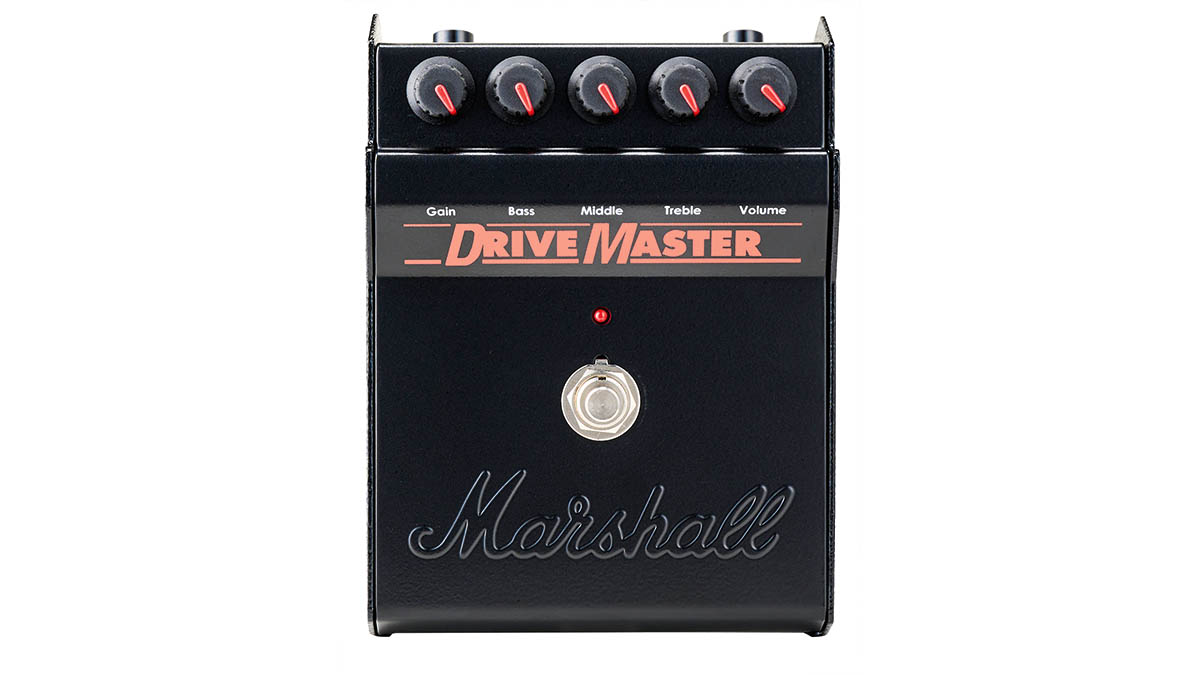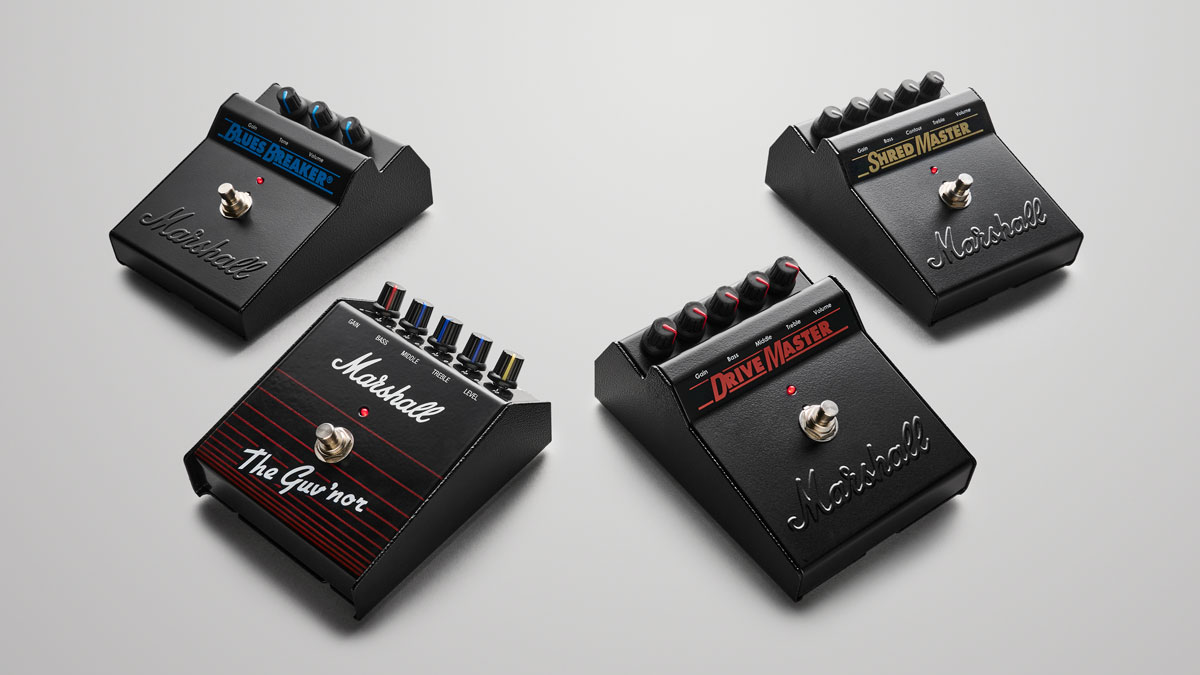Guitar World Verdict
We might be inclined to ask the folk at Marshall why it took them so long, but this is a very welcome return for some classic pedals – and they all sound great.
Pros
- +
Return of some classics.
- +
True copies of the originals.
- +
Solid build quality.
- +
Marshall-flavoured drive.
Cons
- -
Plastic battery cover on three of the pedals could easily go walkies.
- -
Large enclosures for this day and age.
You can trust Guitar World
The company name might be synonymous with guitar amps, but Marshall has been in and out of the pedal game since the SupaFuzz appeared in 1966. That said, it’s been a long time since we’ve seen any new pedals from Marshall, and now four have arrived all at once. However, they’re not strictly new as these are reissues of stompboxes that first saw the light of day in the ’80s and ’90s.
The Guv’nor was the first of these to appear in 1988, while the Drivemaster, Bluesbreaker and Shredmaster trio were first released three years later. All four were gone by around 1998, although Marshall did later bring out some smaller Asian-built versions that didn’t last too long, either.
These new releases, marked as ‘Vintage Re-issue’ on the packaging boxes, are true to those original four black pedals and are made in the Marshall factory in the UK. The metalwork and knobs are exactly the same as before, as are the circuit components – with the exception of the jack sockets and pots as the original manufacturer is no longer in business.
These are solidly built pedals and quite weighty, too. They’re perhaps a little larger than one would like if contemplating the space (or lack of it) on your ’board, but they do have all the connections at the top end, leaving smooth side-cheeks for close side-by-side placement. Power comes via a nine-volt adaptor or a nine-volt battery with access via a metal plate, complete with a single retaining screw on the Guv’nor and an easily removable plastic plate on the other three.
Marshall The Guv’nor

Designed to deliver a typical Marshall amp sound, the Guv’nor pedal was born into an era when the boutique-pedal scene hadn’t really gained momentum and it was well before the concept of an amp-in-a-box pedal (let alone a Marshall-in-a-box pedal) was a thing.
As it is, though, it captures the sound of a Marshall amp perfectly: that classic roar with the distinctive midrange is all here, starting from a bit of crunchy break-up to a stack at full pelt.
The Bass, Middle and Treble controls all work just as you might expect on a Marshall amp and let you tailor that tone to best suit your own rig. Marshall may have been ahead of its time on this one back in 1988, as the designers included a send and return loop on a TRS jack.
All the latest guitar news, interviews, lessons, reviews, deals and more, direct to your inbox!
Get yourself a Y-cable and you can hook up another pedal that will become active along with the Guv’nor when you kick it in. A typical use would be if you were switching on the pedal for solos and wanted a touch of delay in with that lead sound.

Marshall Drivemaster
Once Marshall had seen a successful run with the Guv’nor, the brand moved on to create a new range of three successors. Of the three, the Drivemaster was basically the Guv’nor’s younger sibling and featured the same circuitry, albeit in a new slightly deeper chassis matching the other two newcomers.

Whether it was for consistency and cost-effectiveness in production with just two sockets required (or perhaps they thought it was an underused feature), that send and return socket didn’t appear on the new pedal.
Not as versatile, then, but one advantage that the Drivemaster has over the Guv’nor is its ergonomics, with the knobs repositioned for easy access and easier visual identification of their positions. They’re also set in a recessed position, which means there’s less chance of clobbering them with your foot.
In a side-by-side test, there was minimal sonic difference between the two new reissues, so if you want that sound, then you have an either/or choice.
Marshall Bluesbreaker

There are countless drive pedals that have been based on modified versions of the Bluesbreaker’s influential circuitry, not least Analog Man’s highly regarded King of Tone and its offshoots.
The Marshall pedal was originally named after the 1962 ‘Bluesbreaker’ amplifier, but it’s reminiscent of any Marshall amp that came before the master volume era. This is a soft-clipping pedal as opposed to the hard-clipping of the other three, and it’s also the simplest in terms of its control layout.
There’s not the amount of output you’d find in a modern pedal. Chances are you’ll need the Volume knob at full whack for any Gain knob position below about noon, but that’s how the original was and Marshall has stuck with it. There’s a range here from adding just a little hair to your clean tone through to crunchy break-up – all of which can be tempered with that single Tone knob to get your top-end just where you need it.
Marshall Shredmaster

Coming along not long after the JCM900 amps, the original Shredmaster pedal similarly reflected the higher-gain sounds that hard-rock and metal players had been looking for.
It has the same five-knob array as the Drivemaster but replaces the Middle knob with an extremely effective Contour knob, which scoops out the mids as you turn it up. Advance the gain and you’ll get harmonically rich drive with plenty of compression and sustain, all with a sweet top-end that’s altogether smoother compared with the Drivemaster.
We had to put aside any preconceptions we might have had due to the pedal’s name. While it can do that high-gain shredding thing perfectly well, this is a flexible all-rounder that could suit a whole range of styles, with plenty of great tones also available at lower gain settings.
Verdict
We might be inclined to ask the folk at Marshall why it took them so long, but this is a very welcome return for some classic pedals – and they all sound great.
Keeping as close as possible to the originals has meant missing out on some possible upgrades, such as more output and maybe a smaller chassis for the three-knob Bluesbreaker, but if you want that, there are plenty of boutique alternatives. What you’re getting here is the definitive, real thing, warts ’n’ all.
Specs
Marshall Guv’nor

- PRICE: $249/£169
- ORIGIN: UK
- TYPE: Distortion pedal
- FEATURES: True bypass
- CONTROLS: Gain, Bass, Middle, Treble Level, Bypass footswitch
- CONNECTIONS: Standard input, standard output, standard TRS send/return
- POWER: 9V battery or 9V DC adaptor 6mA
- DIMENSIONS: 112 (w) x 132 (d) x 61mm (h)
Marshall Shredmaster

- PRICE: $249/£169
- ORIGIN: UK
- TYPE: Distortion pedal
- FEATURES: True bypass
- CONTROLS: Gain, Bass, Contour, Treble, Volume, Bypass footswitch
- CONNECTIONS: Standard input, standard output
- POWER: 9V battery or 9V DC adaptor 9mA
- DIMENSIONS: 110 (w) x 147 (d) x 67mm (h)
Marshall Drivemaster

- PRICE: $249/£169
- ORIGIN: UK
- TYPE: Distortion pedal
- FEATURES: True bypass
- CONTROLS: Gain, Bass, Middle, Treble, Volume, Bypass footswitch
- CONNECTIONS: Standard input, standard output
- POWER: 9V battery or 9V DC adaptor 5mA
- DIMENSIONS: 110 (w) x 147 (d) x 67mm (h)
Marshall Bluesbreaker

- PRICE: $249/£169
- ORIGIN: UK
- TYPE: Drive pedal
- FEATURES: True bypass
- CONTROLS: Gain, Tone, Volume, Bypass footswitch
- CONNECTIONS: Standard input, standard output
- POWER: 9V battery or 9V DC adaptor 5mA
- DIMENSIONS: 110 (w) x 147 (d) x 67mm (h)
- CONTACT: Marshall
Trevor Curwen has played guitar for several decades – he's also mimed it on the UK's Top of the Pops. Much of his working life, though, has been spent behind the mixing desk, during which time he has built up a solid collection of the guitars, amps and pedals needed to cover just about any studio session. He writes pedal reviews for Guitarist and has contributed to Total Guitar, MusicRadar and Future Music among others.


